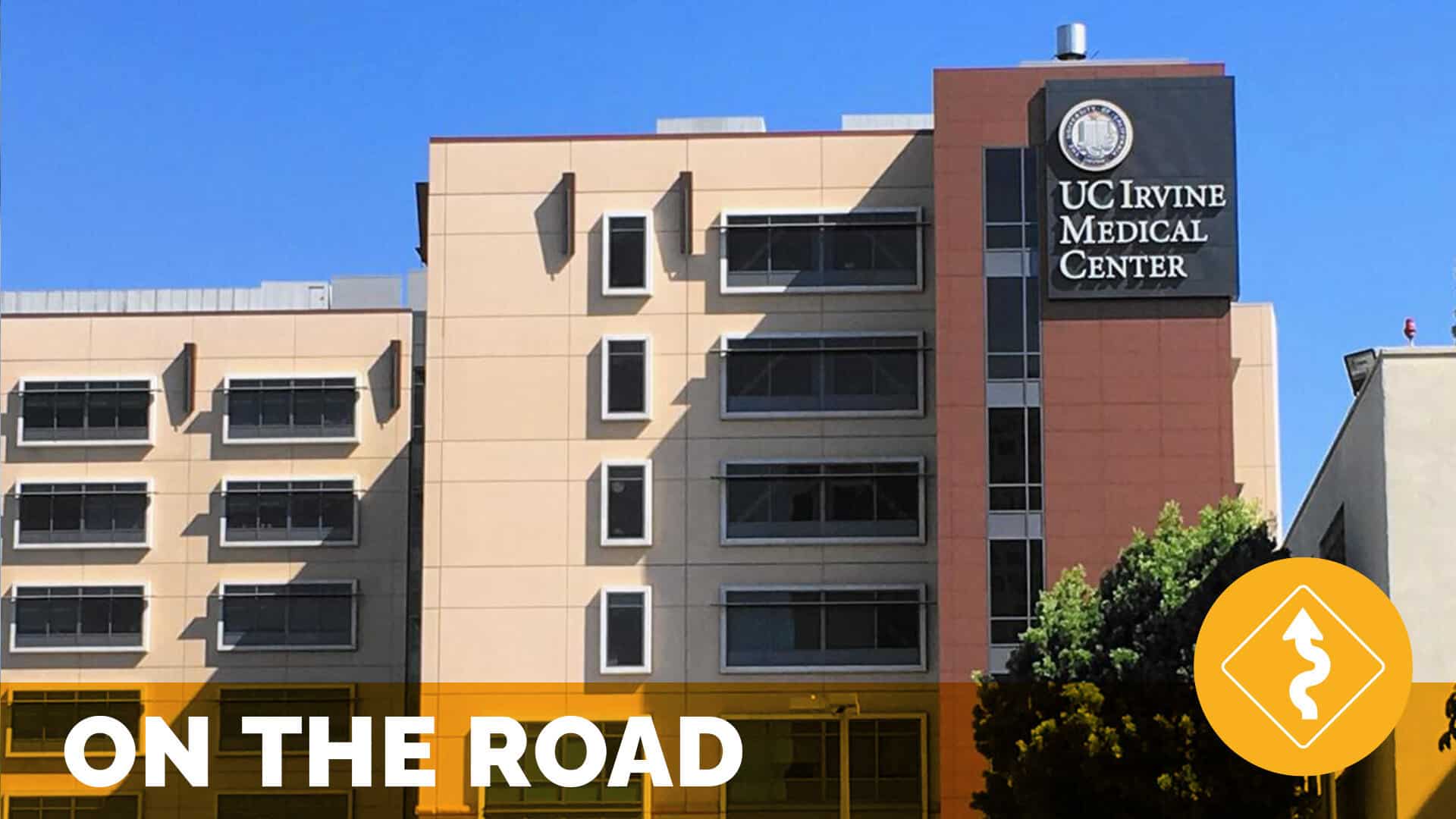Service Excellence – Every Patient, Every Time

On the Road with UC Irvine Healthcare – January 2011
by Jason A. Wolf
On a recent trip to California I had the welcome opportunity to visit with the team at University of California Irvine Healthcare. My hope was to be able to frame a clearly defined effort focused on improving patient experience and get beneath the reasons for success. I was looking to understand what practices could be employed and what lessons were learned in committing focused resources to patient experience success. Hayley McCraney, Director of Patient and Guest Relations, greeted me just outside the front door of the facility. The experience already exemplified a challenge UC Irvine Health was facing. They were in the midst of a significant campus construction effort that made both access and way-finding a challenge, yet here at the very front, or at least one of the temporary fronts to the facility was a core team of valet parkers and friendly volunteer greeters (outside of my welcome from Hayley) designed to help patients and families know they were both welcomed and cared for from their first encounter.
Every Person, Every Time
The energized and thoughtful welcome I saw at the facility entrance was not just unique to the front door. Rather it followed me through my visit in almost every encounter I had with a staff member. I wanted to understand how they achieved that consistency. For this I needed to look no further than a simple, but powerful tool Hayley offered. In a business-card size trifold paper, the service commitment of UC Irvine was laid out. I will be the first to acknowledge that service efforts are not defined by the SWAG (Stuff We All Get), be they brochures, pins, pamphlets or other items. But what I saw here captured what I experienced firsthand from the time I entered the building. I noticed immediately that everyone in the halls, staff at all levels and in all roles acknowledged not only patients and families, but also one another. The facility immediately presented a sense of community, welcome and belonging.
As I looked at the card in my hand, the practice was summed up in the description of the service excellence effort at UC Irvine – Every Person, Every Time. Service excellence and the experience overall is not about some standardized plan or thoughtlessly repeatable processes, it is about the real practice of ensuring each individual receives the experience they deserve. At UC Irvine, they are clear in “How we show we care”.
The five steps include:
1. We make eye contact and smile.
2. We make introductions.
3. We guide guests.
4. We treat our patients, guests and each other like family.
5. We ask, “Is there anything else I may assist you with? I have time.”
While we may not see these ideas as significantly unique, I think we would all agree they are fundamental. It is not in their importance, but in their execution where they have both value and impact. It was evident that within the walls of UC Irvine Healthcare there was a measurable effort to make this happen. Hayley and her team were quick to acknowledge that their effort is a work in process, requiring consistent focus and follow-up, but one that more and more of the members of the UC Irvine team are both aware of and executing on.
Building a Foundation for Success
McCraney and her team shared that the effort began with the support of senior leadership, establishing a Patient Experience Operations Team and a supporting Advisory Board, which included patients. These groups helped guide and support the emerging experience effort. The key was about action and doing.
The process started with creating a consistent service language that everyone could share such as outlined in the five steps mentioned above. The intention was to keep the process simple, focused and purposeful while creating a sense of ownership among staff at all levels. How was this foundation established? Not by a typical training program, but by cross-functional learning opportunities that brought players across all roles together. Rather than training all nurses, all physicians, all housekeepers, etc., the teams that worked together were trained together. They were able to learn from one another’s questions and share the unique issues they faced. The training established how the team at UC Irvine would have to work together to ensure service success.
The program, which was supported and kicked-off by CEO Terry Belmont, was designed to be dynamic and engaging. It was focused on creating a conversation among participants about the keys to the best service experience and about allowing people to talk with one another instead of being talked to. While the training is still being rolled out to all staff, the program is actually requested, not avoided like many new initiatives. “We need to ensure this is both simple and clear so that people are actively engaged in the learning, and more importantly actively engaged in the execution of these ideas,” said McCraney.
The key to this foundation for success is that it became part of every discussion in the Medical Center, not just training that people could check a box and say they attended. McCraney was emphatic in stating, “This not a program, a plan or an initiative, this effort is and must be about how we conduct ourselves every day.” This idea is supported by a critical follow-up component to the learning process, the daily huddle. The huddle has become a central part of the service effort and provides a time every day when each care delivery team comes together around UC Irvine’s service values, ARI²SE, which represents the core values of accountability, respect, integrity, innovation, service and excellence. Here too it seems UC Irvine was willing to take their efforts one step further. As the training is not just a simple required exercise, the service values are not just something posted on a wall. Instead they are integrated into the daily actions of the staff. By conducting huddles in which conversations on each of the service values are addressed, teams can act to identify and rectify service issues in real time. Although these simple processes do not take extensive amounts of time, some in healthcare may see them as a distraction to the care process. The reality for UC Irvine has been the direct opposite of that perspective. By taking the time to stop briefly, huddle and work through issues, they can have a much more significant impact on a patient’s experience overall.
A Framework for Improvement
While information cards, training programs and even service huddles may seem simple solutions, what I saw at UC Irvine was a commitment to recognize the value in the simple tied to a significant focus on execution. This focus was especially exemplified in the integrated efforts to address the HCAHPS domains. During my visit I had the chance to sit down with leaders of the cross-functional teams responsible for helping to improve scores on the HCAHPS composites. While the folks at UC Irvine would tell you that experience is about much more than the scores, their focus represents activity I see all over the US where people are recognizing the impact that HCAHPS has not only on patient perceptions, but the eventual dollars received by healthcare facilities.
UC Irvine has set-up a system of teams, each with responsibility for monitoring HCAHPS performance on a particular domain and then addressing processes or introducing new ideas to help drive improvement in their area of responsibility. Interestingly, these teams are not just working groups outside the day-to-day operations of the Medical Center. In fact, each has a Senior Executive Champion and is lead by Senior Directors from across the facility. One key for the success of these teams is that they follow the core idea of the UC Irvine effort, that cross-functional work has the greatest impact. Composite Teams are not made up of people simply from one area. For example, the team focusing on Communication from Nurses is not made up of nurses alone. Instead a cross-section of voices is included to ensure all perspectives are understood and viewpoints considered as improvement efforts are designed and implemented.
Fred Lauzier, Senior Director of Ancillary Services, also serves as the HCAHPS Composite Team Owner for Cleanliness and Quietness. He presented a great example of this framework for improvement in action. His team discovered in their conversations and planning that there is a difference when you consider actual cleanliness to the perception of cleanliness (on which he suggests hospitals are truly being scored via HCAHPS). What we may deem technically “clean” by all standards in healthcare may not be clean for the patient in that room at that time. (A great example of every person, every time in action.) Fred shared that the team recognized the need to focus on better perceptions of cleanliness in order to perform better on this domain. The solution was simple, asking the patient what aspects of cleanliness were most important to him or her. In knowing what was most important to the patient, these areas could be highlighted. This did not necessarily relate to any additional type or focus in cleaning, but rather it was about ensuring the patient knew you were aware of and addressing their needs. By being aware of needs, housekeepers could be certain to address those areas, even including specific comments on tent cards that were left after cleaning where they specified a focus on the areas important to the patient. What were the results of implementing this simple cross-functional practice? From a baseline score of 48% on this domain, UC Irvine has seen scores now touch 80%.
The key to success shared by Fred and his colleagues was the willingness to engage all the players that could impact the domain, including the patient, in ensuring the best outcome. Even in this example of domain-focused teams, which I have heard others attempt with varied rates of success, I could again see the UC Irvine perspective shine through. By focusing on every person, every time and by ensuring shared contribution through cross-functional involvement in solving problems, the teams found simple, yet highly effective means to ensure the greatest experiences for patients, families and one another.
Lessons Learned, So Far…
During my brief visit with UC Irvine, I was overwhelmed by the sense of service that was part of every encounter and interaction with staff. It was evident that their efforts are taking root. But here too, as in other healthcare organizations where success is flourishing, the team at Irvine acknowledged this was a work in progress. As I asked McCraney and Andrea Herbert, Manager of Patient Experience, about lessons learned they were both very clear about the effort being a journey with no true destination. The top lesson they shared was exemplified by my experience with all the people involved in the UC Irvine service effort. “Service excellence and patient experience success cannot be a mandatory process,” McCraney said. “You need to deinstitutionalize the work to ensure all voices are included. Executive support is essential, but this is not a top-down initiative. Success comes, at least in our case, from cross-sectional and highly engaged involvement at all levels.” Herbert reinforced the importance of having everyone be part of the process. She suggested that by having shared voices in what is going to happen and why, you create a commitment to action and an ownership for outcomes.
Another key lesson included the importance of building on the work that has happened in the past. They collectively agreed that all too often service efforts are positioned as a new idea and we lose the roots of the good work that has come before. By building on the progress of the past you have the opportunity to engage the broadest number of people in the service discussion. By acknowledging that good work has been and will be done, you create a continuum of service that reinforces the foundation on which you can build success. This is part of the idea that service efforts are not initiatives, but truly the way in which people live, breathe and act in the organization every day.
They also suggested the importance of not just focusing on the gaps or what is wrong with the facility. By working simply on the problems, you get stuck in a mindset of having problems to fix. By being clear instead about where you want to go and what you want to achieve you can energize and engage people at all levels to participate. This is an interesting point from which I think we can all learn. While fixing problems is not bad, having a vision about what you can become helps shape a journey that will take shared commitment and effort to realize.
At the end of the day, the lessons, while not complex, are significant. The team at UC Irvine was extremely helpful in reinforcing this. There needs to be support from the top, physicians need to be involved and feel ownership, the voice of the patient must be included, all staff at all levels must have a voice and it cannot just be seen as a plan, but a change in a way of being.
As McCraney said as she walked me back to the door, “You see, it is the way we speak to every person that translates into the patient experience. It is about every person, every time. This is about how we treat each other and it is about how we treat our patients and families.” I can also say it is about how they treat their guests. I was fortunate to have this brief time with the team at IC Irvine, to experience service excellence in their way, as one person, at this time.
Thanks to Hayley McCraney, Andrea Herbert and their entire team. Also thanks to the HCAHPS Composite Team Leaders and other key players helping drive patient experience efforts at UC Irvine, including CNO Karen Grimley who expressed how important the linkage of quality of care and experience truly is. This is something we should never overlook.
Related content
-
 Infrastructure & Governance
Infrastructure & GovernanceConnection Call: Aligning Volunteer Services and Patient Experience for Maximum Impact
12pm ET / 11am CT / 10am MT / 9am PT – We all know that the work that volunteers do in our organizations directly impacts patient experience, but that connection isn’t always clear to your patient experience department. So how do you create and amplify that partnership? Join us as we learn from our
Learn more -
 Infrastructure & Governance
Infrastructure & GovernanceService Recovery for All: The In-Patient Setting
Those working in healthcare have been experiencing the challenges associated with incivility of patients and family members. The workforce needs tools to effectively and confidently have conversations with upset individuals.
Learn more -
 Infrastructure & Governance
Infrastructure & GovernanceExperience Framework Lens: Infrastructure and Governance
Experience Framework Lens: Infrastructure and Governance Effective experience efforts require both the right structures and processes by which to operate and communicate and the formal guidance in place to ensure sustained strategic focus. The Why: Patients should be involved in healthcare governance because their lived experiences and perspectives help create a more patient-centered system. P/F
Learn more
